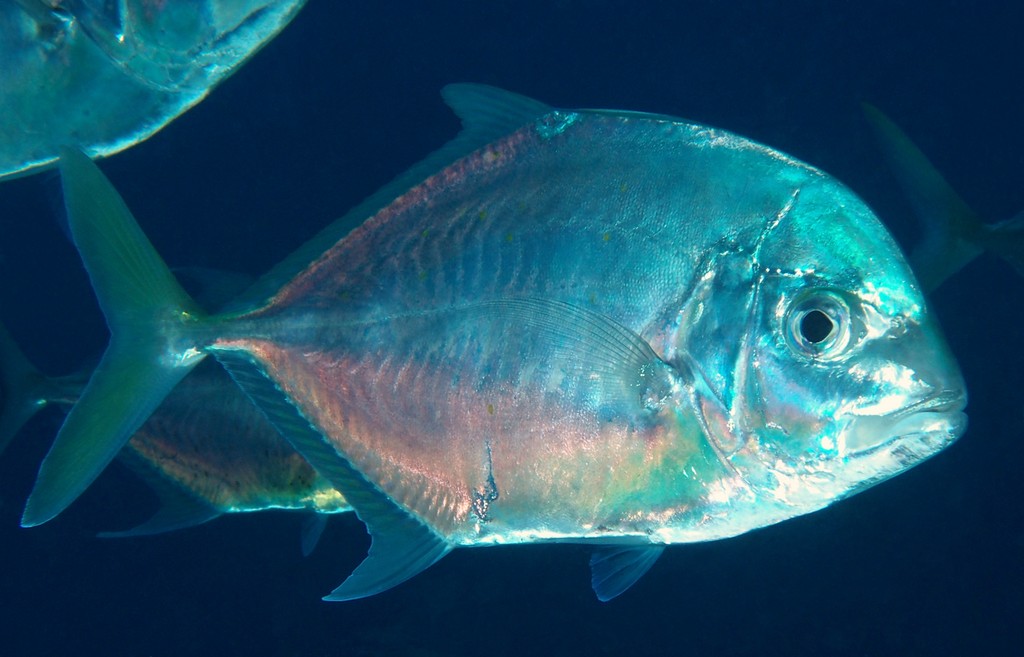TURRUM COERULEOPINNATUM - (RUPPELL, 1830)
Actinopterygii (Gigaclass) > Actinopteri (Class) > Teleostei (Subclass) > Carangiformes (Order) > Carangoidei (Suborder) > Carangidae (Family) > Caranginae (Subfamily) > Turrum (Genus)
Carangue côtière, Carangue oignon, Blue-spined trevally, Bluefin kingfish, Coastal kingfish, Coastal trevally, Diverse trevally, Japanese trevally, Malabar trevally, Onion trevally, Shortfin trevally, Gish-e-darakhshan, Xaréu costeiro, Jurel costero, Kus-koningvis, Ch'ǒng-ga-ra-ji, 유전갱이, Kii-hira-aji, Maru-hira-aji, マルヒラアジ, キイヒラアジ, 广裸若鲹, 青羽若鲹, Cá Khế,
Synonymes
Carangoides altissimus (Jordan & Seale, 1905)
Carangoides caeruleopinnatus (Rüppell, 1830)
Carangoides ophthalmotaenia (Bleeker, 1852)
Carangoides uii (Wakiya, 1924)
Caranx altissimus (Jordan & Seale, 1905)
Caranx coeruleopinnatus (Rüppell, 1830)
Caranx formosanus (Jordan & Snyder, 1908)
Caranx uii (Wakiya, 1924)
Citula coeruleopinnata (Rüppell, 1830)
Citula diversa (Whitley, 1940)
Carangue côtière, Carangue oignon, Blue-spined trevally, Bluefin kingfish, Coastal kingfish, Coastal trevally, Diverse trevally, Japanese trevally, Malabar trevally, Onion trevally, Shortfin trevally, Gish-e-darakhshan, Xaréu costeiro, Jurel costero, Kus-koningvis, Ch'ǒng-ga-ra-ji, 유전갱이, Kii-hira-aji, Maru-hira-aji, マルヒラアジ, キイヒラアジ, 广裸若鲹, 青羽若鲹, Cá Khế,
Synonymes
Carangoides altissimus (Jordan & Seale, 1905)
Carangoides caeruleopinnatus (Rüppell, 1830)
Carangoides ophthalmotaenia (Bleeker, 1852)
Carangoides uii (Wakiya, 1924)
Caranx altissimus (Jordan & Seale, 1905)
Caranx coeruleopinnatus (Rüppell, 1830)
Caranx formosanus (Jordan & Snyder, 1908)
Caranx uii (Wakiya, 1924)
Citula coeruleopinnata (Rüppell, 1830)
Citula diversa (Whitley, 1940)
Turrum coeruleopinnatus (Rüppell 1830)
--------------------------
Description
Dorsal spines (total): 9; Dorsal soft rays (total): 20-23; Anal spines: 3; Anal soft rays: 16-19; Pectoral fin rays: 18-20; Gill rakers: 6-7 + 15-18; Vertebrae: 10 + 14; Curved lateral line scales: 80-99; Straight lateral line scales: 9-19, 21-34 scutes; No scales on the breast to beyond the origin of the pelvic fins. Juveniles have a filamentous lobe on the second dorsal fin. Max. length: 41.0 cm TL, common length: 30.0 cm TL. Depth range: 1 - 60 m.
Color
A silvery grey fish often with five indistinct darker bars and scattered yellow spots on sides, a small black blotch on the upper part of the gill cover.
Etymology
Turrum: word of uncertain origin but is probably Australian aboriginal and refers to any of several species of trevally. A genus of trevallies of large size and with the general facies of Caranx.
coeruleopinnatum: from Latin, coerulus = azure-blue + from Latin, pinnatus = feathered, winged.
Original description: Caranx coeruleopinnatus Rüppell, 1830 - Type locality: Jeddah, Saudi Arabia, Red Sea.
Distribution
Red Sea; Indo-West Pacific: KwaZulu-Natal (South Africa), East Africa, Persian Gulf, Seychelles, Madagascar and western Mascarenes (La Réunion), east to Samoa and Tonga, north to Nagasaki Prefecture (southern Japan), south to northern Australia and New Caledonia.
Biology
Adults are found in deep coastal reefs and rarely inshore. They are usually in small groups over sand bottoms near reefs.
Similar species
Platycaranx malabaricus (Bloch & Schneider, 1801) - Reported from New Caledonia. It differs by having a small area naked of scales anteriorly just above pectoral fin base and more gill rakers on lower limb of 1st arch, with 24 to 27.
Last update: 4, March 2023
--------------------------
Description
Dorsal spines (total): 9; Dorsal soft rays (total): 20-23; Anal spines: 3; Anal soft rays: 16-19; Pectoral fin rays: 18-20; Gill rakers: 6-7 + 15-18; Vertebrae: 10 + 14; Curved lateral line scales: 80-99; Straight lateral line scales: 9-19, 21-34 scutes; No scales on the breast to beyond the origin of the pelvic fins. Juveniles have a filamentous lobe on the second dorsal fin. Max. length: 41.0 cm TL, common length: 30.0 cm TL. Depth range: 1 - 60 m.
Color
A silvery grey fish often with five indistinct darker bars and scattered yellow spots on sides, a small black blotch on the upper part of the gill cover.
Etymology
Turrum: word of uncertain origin but is probably Australian aboriginal and refers to any of several species of trevally. A genus of trevallies of large size and with the general facies of Caranx.
coeruleopinnatum: from Latin, coerulus = azure-blue + from Latin, pinnatus = feathered, winged.
Original description: Caranx coeruleopinnatus Rüppell, 1830 - Type locality: Jeddah, Saudi Arabia, Red Sea.
Distribution
Red Sea; Indo-West Pacific: KwaZulu-Natal (South Africa), East Africa, Persian Gulf, Seychelles, Madagascar and western Mascarenes (La Réunion), east to Samoa and Tonga, north to Nagasaki Prefecture (southern Japan), south to northern Australia and New Caledonia.
Biology
Adults are found in deep coastal reefs and rarely inshore. They are usually in small groups over sand bottoms near reefs.
Similar species
Platycaranx malabaricus (Bloch & Schneider, 1801) - Reported from New Caledonia. It differs by having a small area naked of scales anteriorly just above pectoral fin base and more gill rakers on lower limb of 1st arch, with 24 to 27.
Last update: 4, March 2023
